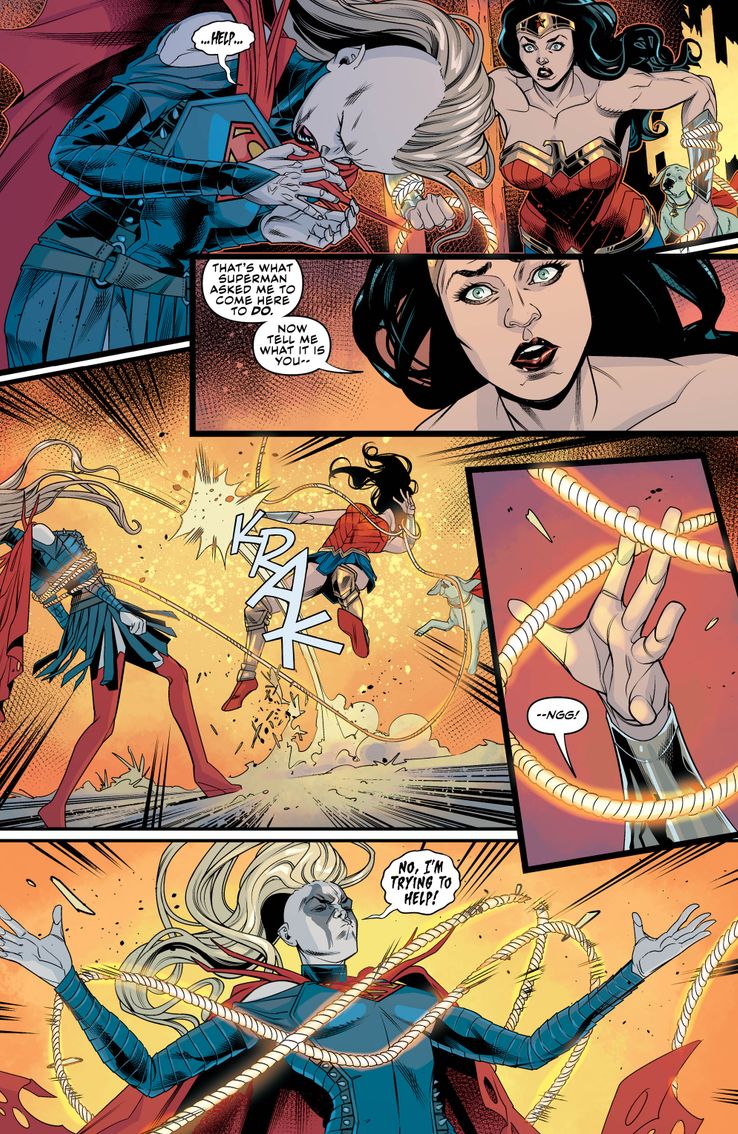The Last Daughter of Krypton fights the Amazonian Princess in an epic battle on the pages of DC Comic’s Supergirl, out this week. Continuing the sage of the Infected Supergirl as she tries to adjust to her new life, Jody Houser and Rachael Stott pull no punches.
It’s a superhero punch-up on a grand scale, but just how long will the U.S. Military sit back and watch? Spoiler: Not very long at all.

Super Dialogue
This issue opens with Supergirl’s speech from last issue being played to a U.S. Military War Room. The General in charge explains the situation to those gathered, with mentions of the Leviathan Event currently happening elsewhere and of Superman’s recent Identity reveal. Here Houser is able to turn a ‘previously in’ introduction into an element of the story. With this opening scene she brings the readers up to date on everything that has happened, in Supergirl and elsewhere, while also introducing a new element to the narrative.
It takes a while for this new element to appear in the comic because there is the whole issue of Supergirl Vs. Wonder Woman. The conversation between Kara and Diana reflects the current personalities of both women. Diana’s pleading for restraint and Kara’s anger and resentment comes through the speech patterns of Houser’s dialogue. This back and forth keeps the pace of the comic moving, assisted by the visual fight scenes.
The reader gets to understand a lot about what is currently making Kara tick at this point. Long time readers will be able to see the struggle happening within Supergirl and the contrast to how she has been represented in previous stories. There is an emotional battle going on within the hero, and Houser illustrates this perfectly within the narrative.

Action Illustrated
With any fight scene in a superhero comic you would expect it to be big and bold and this issue of Supergirl won’t disappoint. A large section of the comic is made up of Kara fighting Diana before yet another fight breaks out. Colorist Cris Peter soaks the pages in action inspired colors. Almost all of the pages are predominantly orange and yellow with inserts of red for the most violent actions.
Tom Napolitano’s lettering serves the script perfectly. The harshness of the contrasting fonts between Supergirl and Wonder Woman highlights the differences in personality. The chaotic appearance of Supergirl’s speech goes one step further as it illustrates the conflict within Kara herself. There is a violent struggle within Supergirl’s psyche which is visualized by the lettering.
Rachael Stott, almost in contrast, has a very clean, precise art style. She uses thin inked lines to define the characters, choosing to focus on the foreground instead of the background. This means that only scenery important to the actual story is illustrated, leaving the action to pop from the page, unhindered by location or setting.
For the most part this approach works, especially within a comic such as this. The story is about the interaction between these two super women and the internal struggle facing Kara; to a vast degree, everything else is immaterial. This point is highlighted within the story itself when Supergirl realizes, in true superhero fashion, the consequences that their fight is having on the local inhabitants.
The drawback of this focus is that any inconsistencies within the art are more noticeable. And there are a number throughout Supergirl #39. There is a moment where Wonder Woman’s Lasso of Truth disappears, causing a brief moment of confusion within the narrative. There are also some questionable anatomical decisions in a few panels, making the reader stop unnaturally, disturbing the rhythm of the comic.
Stott injects the images with energy, and her style brings out the power of the central characters. She is also able to fill the cast full of emotion, alternating between rage and helplessness in the lead role but also giving the supporting cast powerful reaction shots. The locals trapped in the barn are a perfect example of this. Their fear is clearly depicted upon their faces.

Conclusion
Part 3 of the ‘I’m the Bad Guy’ story has the continued action that is required for this type of superhero comic. Everything in this issue is larger than life, bursting with color, and has the conversational banter that keeps the story moving. Houser has a good grip on the balance between the action and the story. She is able to introduce elements into the combat that feed the emotional drama playing out without it feeling forced.
The artistic team also knows where to focus their talents. They concentrate on creating a visual difference between the two fighting women, which is the main aspect of this issue’s narrative. Unfortunately, a few inconsistencies and a plot that requires knowledge of stories outside of this title give this issue a disadvantage.
If you have been reading Supergirl for a while, this issue gives you precisely what you are expecting, but if you’re coming into this cold, it’s going to be a difficult read. It isn’t the best jumping on point, in fact, I’d give it a couple of months and come back for issue 41 when this current story arc is over.

